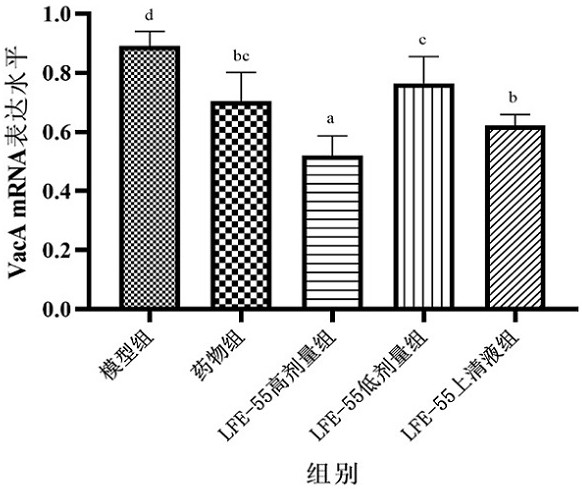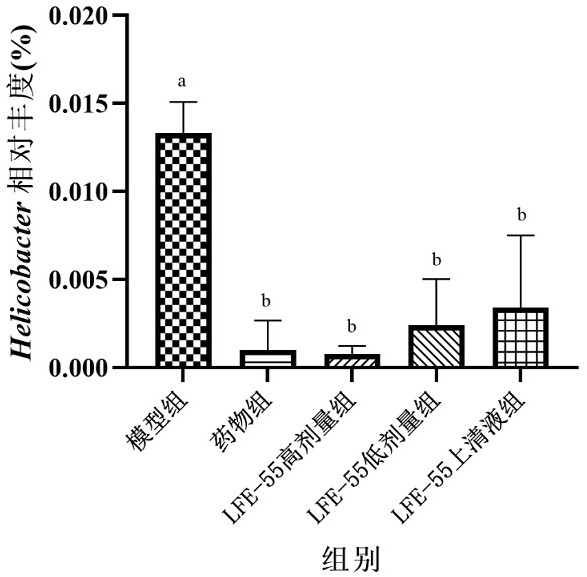Lactobacillus fermentum for inhibiting helicobacter pylori and application thereof
A technology for fermenting Lactobacillus and Helicobacter pylori, applied in the field of probiotics, can solve the problems of high recurrence rate, long course of disease, difficult to cure completely, etc., and achieves the effect of broad application prospects and avoiding environmental pollution
- Summary
- Abstract
- Description
- Claims
- Application Information
AI Technical Summary
Problems solved by technology
Method used
Image
Examples
Embodiment 1
[0029] Example 1 Microbial culture preparation
[0030] Preparation of Lactobacillus fermentedii of the present invention: After two generations of activation of Lactobacillus fermented in MRS medium, inoculated in MRS liquid medium at a 2% inoculation amount for 12 h, centrifugation (4000 rpm, 10 min) to remove the supernatant, after cleaning the body twice with PBS, during gastric lavage, resuspended in 0.9% normal saline and adjusted its bacterial suspension concentration to 1×10 9 CFU / mL。
[0031]Helicobacter pylori was activated on a Colombian blood agar plate, the body was scraped off and washed twice with PBS, then transferred to cerebral heart immersion medium (BHI) containing 5% fetal bovine serum, and the concentration of the bacterial fluid was adjusted to 1×10 after continuing to culture under microaerobic conditions for 48 h 9 CFU / mL and immediately perform an irrigation experiment.
[0032] Lactobacillus fermented with fermented Lactobacillus supernatant: Lactobacill...
Embodiment 2
[0033] Example 2 Animal model
[0034] The experimental animals were selected from SPF-grade C57BL / 6N (5-week-old, female) mice purchased from Beijing Victory Hua Experimental Animal Technology Co., Ltd. Animal experiments were divided into 6 groups, namely blank group, model group, drug group, LFE-55 high dose group, LFE-55 low dose group, LFE-55 supernatant group, each group of 8 mice, a total of 48.
[0035] Mouse feeding conditions: temperature 24 °C, control light for 12 h, dark for 12 h, change the bedding every three days. After one week of adaptive rearing, the gastric mixture of antibiotics (5 mg ampicillin, 1 mg gentamicin sulfate, 5 mg azithromycin) per mouse per day is emptied for 3 days and weighed once a week.
[0036] The blank group was first fed 0.25 mL NaHCO 3 (0.2 mol / L), after 1 h, analytic 0.3 mL BHI medium, every other day, 5 times;
[0037] Model group and intervention group: 0.25 mL NaHCO for gastric first 3 (0.2 mol / L), after 1 h, the concentration of 0.3 ...
Embodiment 3
[0039] Example 3 Detection of virulence factor CagA and VacA
[0040] Expression of virulence factor CagA and VacA: gastric tissue RNA was extracted using the kit, and reverse transcription of RNA was used to cDNA, with cDNA as a template, PCR amplification was carried out, the primer sequence was: CagA upstream primer ATATGCTAAATTAGACAACTTGAGCGA, downstream primer TTAGAATAATCAACAAACATCACAGCGCCAT; VacA upstream primer CTGGAGCCGGGAGGAAAG, downstream primer GGCGCCATCATAAagaGAAATTT. PcR reaction system total 20 μL: cDNA template 2 μL, SYBR Green PCR Master Mix 10 μL, upstream and downstream primers 0.5 μL each, nucleic acid-free water 7 μL; The reaction conditions were: 95 °C for 5 min, 95 °C for 15s, 60 °C for 1 min, a total of 35 cycles. With GADPH as the internal reference, 2 is used -△△Ct The method calculates the relative expression of the gene of interest and repeats it three times.
[0041] CagA mRNA expression levels in each group of mouse gastric tissues were as follows Figu...
PUM
 Login to View More
Login to View More Abstract
Description
Claims
Application Information
 Login to View More
Login to View More - R&D
- Intellectual Property
- Life Sciences
- Materials
- Tech Scout
- Unparalleled Data Quality
- Higher Quality Content
- 60% Fewer Hallucinations
Browse by: Latest US Patents, China's latest patents, Technical Efficacy Thesaurus, Application Domain, Technology Topic, Popular Technical Reports.
© 2025 PatSnap. All rights reserved.Legal|Privacy policy|Modern Slavery Act Transparency Statement|Sitemap|About US| Contact US: help@patsnap.com



